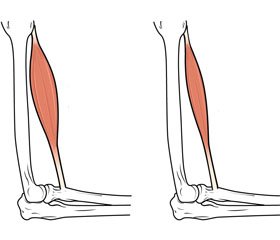The article was published on p. 68-69
Bone is a highly mineralized static organ while muscle is a dynamic organ, built mostly of protein. The main function of the muscles from a mechanical point of view is to transform chemical energy into mechanical Energy and, consequently, to generate power required to move and maintain posture. Muscle cells are formed by the differentiation of mesenchymal stem cells, which are initially converted into myoblasts and then merging and extending to form myotubes. In the process of maturation within myotubes actin and myozin filaments are formed. The key phase for the emergence of the muscle cells is the attachment of the neuromuscular junction. Muscle contraction is based on myofibrils containing actin and myosin myofilaments. For one thick filaments of myosin there are two halves of thin filaments of actin. Muscle contraction is the result of inserting the filaments of actin filaments on myosin.
According to the clinical definition developed by the European Working Group on Sarcopenia in Older People, sarcopenia is a syndrome characterized by a progressive and generalized loss of muscle mass and strength with the consequential risk of disability, poor quality of life and death. A decrease in muscle mass and strength and/or speed is a diagnostic criterion of sarcopenia. For the measurement of muscle mass the following are used: magnetic resonance imaging, computed tomography, densitometry and bioimpedance. Magnetic resonance imaging is by far the most accurate method, however costly and time-consuming. Computed tomography is also an accurate measurement method, yet, exposes a patient to high radiation dose. The optimal measurement is the so-called Body Composition performed by means of a densitometer. It distinguishes fat mass and lean body mass. It is basically used to measure the ASM — Appendicular Skeletal Muscle Mass (the norm for women equals 5.5 kg/m2, men 7.23 kg/m2). Bioimpedance is an non-invasive and inexpensive method, however, it exhibits a poor sensitivity (standard according to BIA — women 6.2 kg/m2, men 8.6 kg/m2). Muscle strength is assessed by means of a dynamometer with patient clenching the hand on a handle (the norm for women > 20 kg, men > 30 kg), while the speed is measured by gait speed (> 0.8 m/s) or timed up and go.
The aging is one of the main causes of sarcopenia (similarily as in the case of osteoporosis). Sarcopenia incidence increases with age, ranging from 15 % after 60 to as much as 50 % over 85. The main causes of aging are: the loss of energy production ability in mitochondria, telomere shortening, metabolic waste (free radicals, toxins). The development of sarcopenia is also affected by hormonal factors (testosterone, estrogen, growth hormone/IGF-1), humoral factors (subliminal chronic inflammation) and environmental factors (diet, sedentary lifestyle).
Regular physical activity and proper diet are the only effective methods for both the prevention and treatment of sarcopenia, as per the EBM criteria. The most effective exercises are resistance exercises, particularly progressive resistance training, affecting both the increase in strength and muscle mass. In turn, the lack of physical activity — whatever the reason — triggers muscle atrophy. The second key element in treating sarcopenia is a diet modification: a proper protein and vitamin D3 intake. The recommended consumption equals 0.8–1.2 g of protein per kg of body weight per day. Proteins provide the appropriate course of postexercise regeneration processes and are an important anabolic stimulus for skeletal muscle. Vitamin D3 stimulates the synthesis of myocytes, their differentiation, inhibits apoptosis, affects the conductivity and muscle contraction.
According to the EBM muscle weakness is considered as particularly predisposing to falls — for this reason sarcopenia is a fall risk factor. Other important fall risk factors are: balance disorders, vision disorders, cognitive function conditions, insufficient physical activity, age above 80. Due to such aging factors as depleting biologic reserves, slow reflexes and osteopenia or osteoporosis a seemingly harmless fall from own height can have serious consequences and the most serious are fractures, which in the elderly can cause not only pain and temporary immobilisation, but also a permanent impairment of mobility, functional deterioration, increasing morbidity and mortality.
In falls prevention the main Focus must be placed on improving the efficiency of gait, balance and coordination and efficiency of the cardio-respiratory system. A special attention should be paid on various forms of physical activity. Regular exercise of moderate intensity is recommended at least 3 times a week: Nordic Walking, Tai-Chi, dancing, brisk walking. The most effective exercise plans are those under the guidance of instructors in fall prevention centers (e.g. The Falls Prevention Service of Shropshire Community Health NHS Trust, Falls Prevention Team of Berkshire Healthcare NHS Foundation Trust) and individually tailored home exercise programs.

